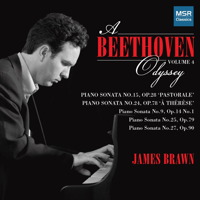
Pure Magic
James Brawn's continued
Beethoven Odyssey -
awaited by
ANDREW SCHARTMANN'... generating excitement with raw textures ...'
|

|
This disc marks the halfway point of James Brawn's ambitious project to record all thirty-two of Beethoven's piano sonatas. Like the first three volumes, the fourth is replete with dazzling technique, expert phrasing, and sensitive voicing. But these are not the things that keep me coming back time and time again to Brawn's recordings. It's the intellectual nature of his playing that has my ears begging for more. So often I find myself raising an eyebrow at one of Brawn's artistic decisions, only to be won over by his 'argument' as a whole — his overall conception of a work.
This attention to large-scale form, ie, the grand arc of a multi-movement piece, is front and center in the second movement of Beethoven's Piano Sonata in E major, Op 14, No 1. Brawn's tempo is on the slow side, and he plays with a healthy amount of rubato. Perhaps strange in isolation, this interpretation works wonders for the structure as a whole, with the slightly 'loose' and melancholic middle movement sandwiched between two boisterous outer movements. Brawn's heavy push and pull in the Allegretto enhances the energetic opening of the finale, which he performs with metronomic precision — with one exception. Note the brilliant hesitation that heralds in a softer dynamic. Only a master could make this shift so effortlessly.
Listen — Beethoven: Allegretto — Rondo (Piano Sonata Op 14 No 1)
(track 2, 3:29-track 3, 0:26) © 2015 James Brawn:
The finale also provides a more local example of Brawn's sensitivity to musical form. In the rondo movement's first couplet, Brawn combines detailed voicing with a carefully controlled dynamic arch to convey a hierarchy of sustained gestures — the shorter ones nested within the longer ones.
Listen — Beethoven: Rondo (Piano Sonata Op 14 No 1)
(track 3, 1:01-1:48) © 2015 James Brawn:
Brawn continues his mastery of long dynamic threads in the 'Pastorale' Sonata, Op 28. The piece opens with one of Beethoven's more unusual (and lengthy) main themes, which features enough repetition to drive any pianist mad. How do you incorporate enough variety while shaping a coherent thirty-nine-measure phrase? Brawn's solution is elegant, but simple: he allows Beethoven to do most of the work. Rather than forcing dynamic swells and elastic timing onto the music, Brawn focuses on texture, bringing out the subtle changes in 'orchestration' that characterize each phrase. When treated orchestrally, the passage shapes itself.
Listen — Beethoven: Allegro (Piano Sonata Op 28)
(track 4, 0:00-0:37) © 2015 James Brawn:
Brawn's interpretation of this passage is noteworthy in another respect: instead of a deep and warm sustained tone (as has become standard for these measures), he opts for a drier, less resonant sound. Some might find the result acerbic, but it works wonders when juxtaposed with a more resonant section. This is precisely what happens in the finale. Following a highly articulate opening, the arpeggiated descending thirds sequence takes on a lush character that wouldn't otherwise be possible. Whether intentional or not, Brawn's use of pedal to delineate the form enriches his playing considerably.
Listen — Beethoven: Rondo (Op 28)
(track 7, 0:00-0:39) © 2015 James Brawn:
Using pedal as a form-defining element also forces Brawn to be extremely clear in his phrasing. This clarity is most noticeable in the bass voice, which Brawn never sells short. There's no such thing as a muddy left hand in his playing. Each and every bass line is meticulously sculpted, as in the Allegro Vivace of Op 78.
Listen — Beethoven: Allegro vivace (Op 78)
(track 9, 0:00-0:51) © 2015 James Brawn:
This exposed sound brings Beethoven's contrapuntal frame to the fore. It also adds to the music's overall punch by highlighting Brawn's exuberant fingerwork, the precision of which creates more energy than sheer force ever could. In fact, generating excitement with raw textures is one of Brawn's best and most-used tricks. The opening movement of Op 79, which he takes at a daring pace, provides yet another example of this impressive bare-bones playing.
Listen — Beethoven: Presto alla tedesca (Op 79)
(track 10, 0:00-0:41) © 2015 James Brawn:
It's also worth noting that Brawn slows down just a touch as he enters the transition between themes. This willingness to flex tempi between sections is a vestige of historically informed performance practice, the revival of which is quite bold (at least on a modern instrument). But it is precisely these kinds of risks that make Brawn's recordings so exciting. To paraphrase the late Glenn Gould, don't record unless you have something new to say. James Brawn certainly does. And I urge you to partake in his historical project, which is nothing short of magical. Listen to the control, the musicianship, and the artistry. Masterful. Mesmerizing. Pure magic.
Listen — Beethoven: Nicht zu geschwind ... (Op 90)
(track 14, 0:00-0:52) © 2015 James Brawn:
Copyright © 24 June 2015
Andrew Schartmann,
Connecticut USA

| 
